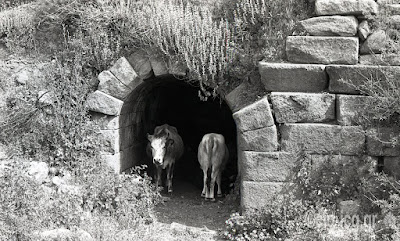As my time in Athens inches closer to the end, I must reflect on the
last three months and what I have been able to accomplish. I came to
Athens in mid-September from my much smaller home town. I first heard of
the Canadian Institute in Greece internship program at my university
back in my first year and was ecstatic at the idea of being able to live
and work in Athens for 3 months. When that time came for me to apply at
the end of my third year, I was more than delighted for this amazing
opportunity to start.

Working at the Canadian Institute, my main task was to archive a group
of old institute files. I worked tirelessly though my 3 months to
digitize all the files and organize them into a consistent manner that
would provide easy accessibility for any future researchers. This often
included the rearrangement of several files and the redistribution of
many documents. I ended this major project by physically archiving the
documents within the Institute’s archive room and keeping a digital
record of all documents and their location. Along with my archive
project, I was also responsible for some small maintenance tasks of the
Hostel and administrative tasks and errands in assistance to Jonathan.
This mainly included laundry, running errands, and delivering and
picking up packages. I was also responsible for the food and beverages
at the Institute events.

The shock from coming from a small city to the hustle and bustle of the
large city of Athens quickly wore off as I became more comfortable with
the city through my own exploration. The city’s metro was easy to use
and the bus system carried to me areas beyond the reach of the metro. My
first goal while in Greece was to become as familiar with the city as
possible and I accomplished this through many evening and weekend visits
to the major and minor sites and museums of Athens. I was able to the
visit the Acropolis, Hadrian’s Arch and Library, Temple of Olympia Zeus,
both Agoras, Panathenaic Stadium, the Aeropagus, Lycabettus Hill,
Filopappou Hil, Kerameikos the National Archaeological Museum, the
Byzantine and Christian Museum, the War Museum, the Acropolis Museum and
all the minor museums within all of the sites.

My second goal while in Greece was to visit some of my favorite sites
outside of Athens that I had spent years learning about in my classes. I
was thankful that the Bus Company KTEL was easy enough to use as it was
my primary source of transportation outside of Athens. I was able to
travel to Mycenae, Nafplio, Delphi, the sanctuary of Asklepios
Epidavrous, Aegean, Ancient Corinth, Cape Sounion, Eleusis and the
Sanctuary of Demeter and Kore, and Crete to see Knossos. I was almost
able to complete my very long list, but three months is not long enough
to travel around an entire country. At least it gives me incentive to
return to beautiful country.

During my time in Greece I have also spent my time in Athens
attending lectures at the other international Institutes, volunteering
at the Weiner Lab at the American School of Athens, visiting the cinema
to watch the latest movies, eating at the many cafes and taverns, and
visiting the main shopping areas like Syntagma Square, the flea market
and tourist districts, and the several shopping malls. I have used this
experience to educate myself on the archaeological community within
Greece and the country as a whole. This entire experience has been eye
opening, unforgettable and very enjoyable. I am very excited and hopeful
to return in the future.
Sarah Cozzarin,
Wilfrid Laurier University intern, autumn-winter 2017






















